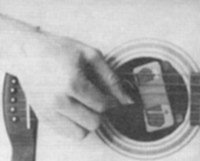Leo Kottke: Fingerstyle Visionary Learns From Tradition
by Mark Hanson
Page 4
Now that you are concentrating on the 6-string, do you still play the 12-string?
Year, I carry a Martin cutaway on the road. It's a converted D-12-20. It has a 28" string scale, so it isn't pleasant to fret. [Ed. note: Standard scale length on a six-string guitar is 25 1/2".] I use it mostly for slide. [Berkeley, California, luthier] John Lundberg converted it for me. I made it into a 10-string. It probably will return to 12-string status if I ever stop using a magnetic pickup. The octave G and D-strings were just too loud.
Do you own other 12-strings?
I own a couple of Taylor 555s [Taylor Guitars, Box 65, Lemon Grove, CA 92045; jumbo mahogany model]. The one I just got is braced differently. It has a lot less wood in it. I'm working with Bob Taylor on a new design for a 12 string. We're experimenting, moving the braces around. I hope that it will he ready in the next 12 to 18 months.
Why have you had the pickguards taken off all your instruments?
I think that a pickguard pinches the treble notes. It narrows the notes too much. That's definitely true of older Gibsons; not so much of Martins. And you won't hurt the top as long as you don`t use picks.
Would you describe your tuning technique for 6- and 12-strings?
For standard tuning I get an A from a tuning fork. Then I compare the open strings to each other. I don't use harmonics to tune. I think you should be able to hear if your open strings are in tune with each other. Then I check an A chord without a third in it [See Ex. 2]. Then I check it by going up to a D chord [Ex. 3]. Another one I check is an E chord without a third in it [Ex. 4]. These chords seem to work for most guitars that are in good shape. I use the same tuning technique for the 12-string.
Do you use an electronic tuner?
I carry tuning forks. I've got a couple of tuners that I carry for festivals or loud clubs. But I started using them when I didn't need them, and before long I couldn't tune anymore. It erased my ear. Someone had told me that would happen. Maybe I'm just susceptible to suggestion [laughs]. The tuning problem is one reason I don't do much open tuning stuff now when I perform.
What guitars besides the Martin 12-string are you currently using in performance?
I only carry two: the Martin and a Charles Hoffman Series II 6-string [Ed. note: Minneapolis luthier Hoffman has contributed lutherie articles and columns to Frets since 1981.] Each note on the Hoffman is very apparent. There isn't a lot of that internal resonance. I used it on the new record. Hoffman is a lawyer now. But he still has his shop and builds occasionally.
What guitars do you play around the house?
I love Old Gibsons. I have a J-50. I have a wonderful guitar from Bob Benedetto [Benedetto Guitars, 2101 Sunnydale Blvd. Unit DD, Clearwater, FL 33575]. It's an archtop electric with an oval soundhole. When it's plugged in, the thing has more character than just about anything.
Are there other guitars you wished you owned?
My classical guitar teacher, Stanley Watson, had a guitar made out of a guitarron. You held this huge guitarron, but it had an eight-fret guitar neck with six strings. That was probably the greatest guitar I've ever played. It knocked down walls, but you could be as delicate as you wanted on it. Maybe one of your readers knows where it is. I think it belonged to one of the Buskin & Batteau duo. I don't think it had a brand name. I was just an experiment.
I see you are still using a Bill Lawrence magnetic pickup.
Yeah. I've used it for a long time now.
 |
A common problem with magnetic pickups is that the B string seems much louder than the other strings. How do you overcome that?
I break a medium size cotter pin [about one inch long, with flat sides] in half, and use silicone sealant to attach it to the pickup. I put it right under the B-string, parallel to it [See Fig. 4]. The metal seems to diffuse some of the signal from the B string. It doesn't solve the problem entirely, but it really makes a big difference. I'm using white bronze GHS strings that I think have a real nice sound.
They look like nickel-wound strings.
There is no bronze in them. I like steel strings better than bronze. Bronze strings are a little too "hot" for my ear. Michael Hedges uses steel. These are standard lights. They package them with a .012 E-string, but I use a .013. The gauges I use are .013, .016, .024, .032, .042. and .054.
